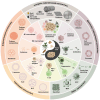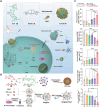Integration of active ingredients from traditional Chinese medicine with nano-delivery systems for tumor immunotherapy
- PMID: 40382641
- PMCID: PMC12085060
- DOI: 10.1186/s12951-025-03378-y
Integration of active ingredients from traditional Chinese medicine with nano-delivery systems for tumor immunotherapy
Abstract
Tumor immune escape presents a significant challenge in cancer treatment, characterized by the upregulation of immune inhibitory molecules and dysfunction of immune cells. Tumor immunotherapy seeks to restore normal anti-tumor immune responses to control and eliminate tumors effectively. The active ingredients of traditional Chinese medicine (TCM) demonstrate a variety of anti-tumor activities and mechanisms, including the modulation of immune cell functions and inhibiting tumor-related suppressive factors, thereby potentially enhancing anti-tumor immune responses. Furthermore, nano-delivery systems function as efficient carriers to enhance the bioavailability and targeted delivery of TCM active ingredients, augmenting therapeutic efficacy. This review comprehensively analyzes the impact of TCM active ingredients on the immune system and explores the synergistic application of nano-delivery systems in combination with TCM active ingredients for enhancing tumor immunotherapy.
Keywords: Active ingredients; Drug delivery; Nanocarriers; TCM; Tumor immunotherapy.
© 2025. The Author(s).
Conflict of interest statement
Declarations. Ethics approval and consent to participate: Not applicable. Consent for publication: All authors declare full consent for publication. Competing interests: The authors declare no competing interests.
Figures






Similar articles
-
Research progress of nano drug delivery systems in the anti-tumor treatment of traditional Chinese medicine monomers.PeerJ. 2025 Apr 24;13:e19332. doi: 10.7717/peerj.19332. eCollection 2025. PeerJ. 2025. PMID: 40292112 Free PMC article. Review.
-
Review on anti-tumour lipid nano drug delivery systems of traditional Chinese medicine.J Drug Target. 2025 Jun;33(5):704-716. doi: 10.1080/1061186X.2024.2448708. Epub 2025 Jan 3. J Drug Target. 2025. PMID: 39743936 Review.
-
Polysaccharides from traditional Chinese medicine and their nano-formulated delivery systems for cancer immunotherapy.Carbohydr Polym. 2025 Jun 1;357:123416. doi: 10.1016/j.carbpol.2025.123416. Epub 2025 Feb 20. Carbohydr Polym. 2025. PMID: 40158963 Review.
-
Nanotechnology-based drug delivery system for targeted therapy of ulcerative colitis from traditional Chinese medicine: A review.Int J Pharm. 2025 Mar 30;673:125375. doi: 10.1016/j.ijpharm.2025.125375. Epub 2025 Feb 16. Int J Pharm. 2025. PMID: 39965734 Review.
-
Harnessing the Power of Traditional Chinese Medicine in Cancer Treatment: The Role of Nanocarriers.Int J Nanomedicine. 2025 Mar 13;20:3147-3174. doi: 10.2147/IJN.S502104. eCollection 2025. Int J Nanomedicine. 2025. PMID: 40103746 Free PMC article. Review.
Cited by
-
Traditional Chinese medicine in the treatment of breast Cancer.Mol Cancer. 2025 Aug 1;24(1):209. doi: 10.1186/s12943-025-02416-5. Mol Cancer. 2025. PMID: 40750898 Free PMC article. Review.
References
-
- Nong C, Guan P, Li L, Zhang H, Hu H. Tumor immunotherapy: mechanisms and clinical applications. MedComm Oncology. 2022;1:e8.
-
- Hui Z, Wen H, Zhu J, Deng H, Jiang X, Ye XY, et al. Discovery of plant-derived anti-tumor natural products: potential leads for anti-tumor drug discovery. Bioorg Chem. 2024;142: 106957. - PubMed
-
- Wei D, Yang H, Zhang Y, Zhang X, Wang J, Wu X, et al. Nano-traditional Chinese medicine: a promising strategy and its recent advances. J Mater Chem B. 2022;10:2973–94. - PubMed
Publication types
MeSH terms
Substances
Grants and funding
LinkOut - more resources
Full Text Sources
Medical

